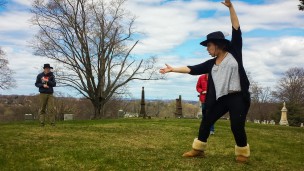
It’s hard to find a better example of metatheater than Tom Stoppard’s “Rosencrantz and Guildenstern & Dead.” The play follows two minor players from Shakespeare’s “Hamlet” and traces their own stories behind the scenes of the great tragedy. Scenes and characters are borrowed directly from “Hamlet” and then mixed with absurdist banter and a strong dose of existential dread.
But “Rosencrantz & Guildenstern,” more than anything else, is about theater. It lovingly mocks and connects with a 400-year-old classic as it puts on plays within plays and fills itself to the brim with theatrical in-jokes. “Don’t you get it?” one character eventually exclaims. “We’re actors! We’re the opposite of people!”
And so director Dan Bachman ’17 makes a rather interesting choice to produce metatheater without the theater. Situated on Indian Hill, the production does not only have minimal tech; it has no tech at all. There is no set, no light or sound cues, and only a handful of props and costume accessories. The cast of four must rely on their performances alone to carry the show.
“It really makes us work harder as actors and pushes us to our limits,” said actress Hannah Skopicki ’18.
She is one of the show’s two “players.” She and Emmet Daly ’18 pop in from time to time to portray any character from the script who isn’t Rosencrantz or Guildenstern. With a touch of mime makeup, they not only switch characters on a whim but also play the same character at different points. Skopicki portrays Hamlet for his pivotal “to be or not to be” soliloquy while Daly portrays him in his first and final appearances. The two actors balance each other well, and are generally just fun to watch.
“Communication was definitely key in creating all of our characters,” Skopicki said, “I spent a lot of long nights just working on each persona, and we just wanted to make sure that ours were as similar as possible while making each character distinct.”
Skopicki’s presence commands attention, even when she is required to hump the ground. Meanwhile, Daly exhibits an impressive range as he switches from a mute, meek assistant to a dignified queen. However, the players are merely the ensemble to Rosencrantz and Guildenstern, who are “on stage” for virtually the entire show. Respectively, Michael Matthews ’15 and Hazem Fahmy ’17 face some of the greatest acting challenges imaginable. Not only do they have to deliver the vast majority of the show’s fast-paced, repetitive dialogue, but they also have to make that repetitive dialogue engaging through only their constant animation and delivery. And they base those performances on a 1960 script that takes its characters from a 1603 script.
“That was kind of what drew me to this, that you could almost consider this Rosencrantz and Shakespeare’s Rosencrantz to be the same,” Matthews said. “Because Shakespeare’s Rosencrantz is functionally nonexistent.”
Stoppard’s Rosencrantz might be even more nonexistent, as he and Guildenstern share meaningless banter reminiscent of a more comedic “Waiting for Godot” for extended periods of time. But they also interact directly with Hamlet, Claudius, Ophelia, and the rest of the Shakespeare crew. This particular production demands an in-depth understanding of “Hamlet,” and offers no favors to the audience if they lack it. We are expected to understand which characters the players are portraying even with the most minimal of costume changes, which becomes even more difficult when the players sometimes both play the same character but in different sequences.
While the players play everyone, Matthews and Fahmy face the difficulties of playing no one.
“It’s an interesting challenge to bring something interesting to the table when you’re performing as a character that explicitly has no personality, whose main trait is the inability to grasp anything really solidly conceptual,” Matthews said. “So that just comes down to a lot of fun with line readings. How many different ways can I claim to have forgotten something?”
Matthew’s Rosencrantz consistently clashes with Guildenstern in demeanor and personality, and this drives much of their banter. Really, consistency is the core of this production. Bachman uses the technical minimalism to reduce the peaks and valleys of the script’s energy, instead making the show feel like a two-hour existentialist conversation (or, at times, an existentialist screaming match). The chilliness and surrounding graveyard of Indian Hill certainly adds to this aesthetic.
Stoppard’s script explores absurdity and meaninglessness; similar to last week’s “Bald Soprano,” “Rosencrantz & Guildenstern Are Dead” makes one wonder if anything has any meaning or if any characters are beings at all. “We have no control!” Rosencrantz shouts in the final act, “None at all!” But what makes “Rosencrantz & Guildenstern” unique is that it does this while examining our relationship to art and narrative itself. Do characters have any meaning outside their roles in a script? Do actors have any meaning outside their role in a play? Stoppard examines that from multiple angles with his play alongside a play (and play within a play).
While the choices of minimalism and location (the rain date alternative is the Nicolson Lounge) inhibit that meta-commentary and purpose of the play, the Indian Hill graveyard emphasizes the “dead” part of “Rosencrantz & Guildenstern Are Dead” in a manner that is in no way subtle. And death is surely a very important part of the play. The two leads ponder death and eternity to great length, in true existentialist fashion. It also helps that the sun actually can be seen setting in a show that keeps mentioning a setting sun.
Ultimately, this “Rosencrantz & Guildenstern Are Dead” finds new meaning by stripping the show of its original meaning, which Stoppard would probably appreciate.
“Rosencrantz & Guildenstern Are Dead” presents itself on Indian Hill on Friday, May 8 through Saturday, May 10 at 5 p.m.


Leave a Reply